9 SMS Marketing Best Practices to Help You Text Smarter
Discover 9 SMS marketing best practices that can help you text smarter and have more successful marketing campaigns.
Published
November 3, 2025

Most people check their phones within seconds of getting a text. That’s what makes Short Message Service (SMS) such a powerful tool for businesses.
With conversational SMS marketing, you can communicate with customers rather than competing against crowded email inboxes or social media ads.
But while it gives you instant access to your audience, it also comes with a need for balance. Sending too many messages or using the wrong tone can quickly drive people away.
In this article, we’ll talk about the best SMS marketing practices you can implement to grow your business. You’ll see how a few simple adjustments in timing and structure can transform ordinary texts into high-converting messages that your customers look forward to receiving.
1. Focus on Permission-Based Growth
Every good SMS marketing strategy starts with permission. Texting people who did not ask to hear from you is the fastest way to lose trust and probably get reported.
You can use simple sign-up methods, such as adding opt-in forms to your website, keyword QR codes, checkout pages, or text-to-join campaigns.
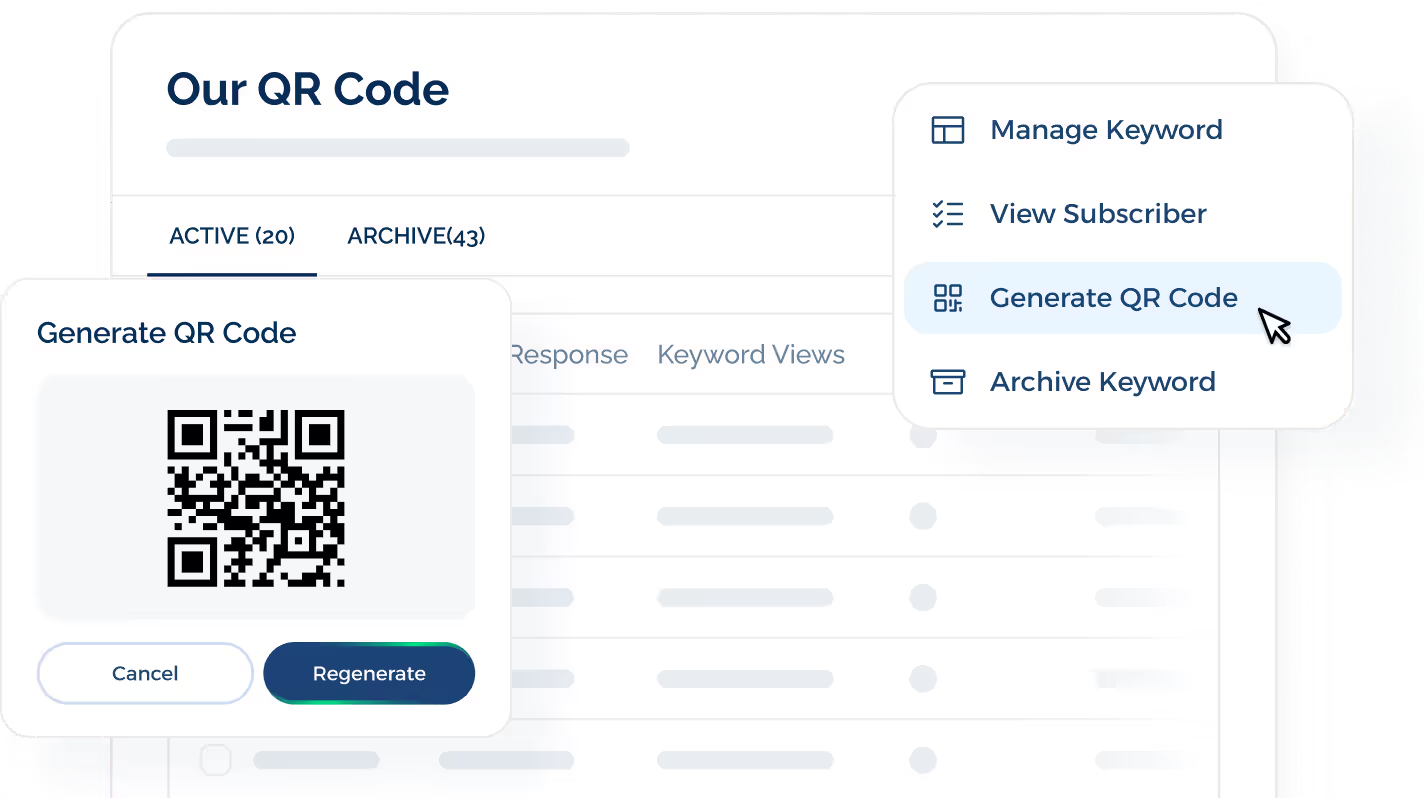
You may also offer something in return, such as a discount, free shipping, or early access to sales, to motivate users to join. Always include an SMS opt-out option in every promotional message so people can leave if they want to.
You can use a double SMS opt-in process to stay compliant. After someone signs up, they should receive a confirmation text message to verify their interest. This extra step filters out fake numbers and confirms genuine subscribers.
The Cellular Telecommunications Industry Association (CTIA) plays an important role here. It’s a trade association that represents the wireless communications industry in the United States.
It sets voluntary best-practice guidelines for SMS and MMS marketing, covering consent, privacy, message frequency, and content.
Once you collect phone numbers, you need to store them safely and never share them with other parties. A smaller, fully opted-in list will always perform better than a large one filled with unverified contacts.
Stay compliant and keep your business texting safe. Choose TextUs and book a demo today!
2. Segment Your Audience
SMS segmentation means dividing your list into smaller groups based on what people like, buy, or do. It helps you send targeted messages that match each person’s needs instead of random texts that feel off.

You can start with basic information such as location, gender, or age. For example, if you run a clothing store, you can send promotional text messages to women about new arrivals while sending clearance alerts to another group.
You can also group your audience based on activity level. Active customers can get early sale access, while less engaged ones might receive a simple text message marketing discount to draw them back in.
The goal is to create a link between what you know about your subscribers and what you send them. Segmentation turns SMS marketing efforts into smarter communication that respects each person’s interests, leading to more replies and stronger loyalty over time.
3. Personalize Every Message
Personalization is what separates spam from a real connection. When you use customer data to make the message feel personal, they read it and act right away.
Simple touches like including the customer’s name or location in a text message can make a huge impact. These small details make customers feel noticed and valued.
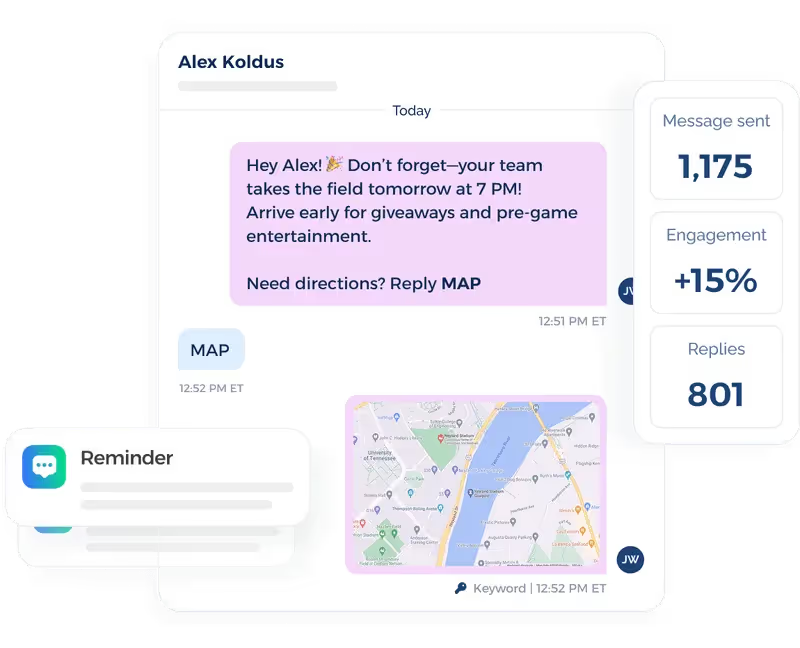
You can also go beyond names by using purchase history and browsing patterns. With the help of marketing tools, you can see what customers have bought or shown interest in. Then you can create promotional SMS marketing messages that highlight related items or limited offers.
Personalization also helps with timing your SMS. When a person usually interacts with your messages, you can schedule your SMS marketing campaigns during that window.
Data on customer behavior shows that sending messages based on a user’s activity or preferences improves response rates far more than random scheduling.
The best conversational texting approach combines automation with real tone. SMS marketing software can send messages automatically, but they should still sound like a human wrote them.
4. Balance Frequency and Relevance
The success of SMS marketing efforts depends on how often you send texts. Fewer, well-planned messages with value build stronger connections than a flood of irrelevant updates.
You can set a schedule that matches your business type and aim for steady contact that keeps your audience aware of you without overwhelming them. For most companies, 2-4 texts per month work well, but you should test what your target audience prefers.
Make sure to keep your messages concise. Short text messages perform better than long ones as customers appreciate simple communication that respects their time.
You also need to avoid texting customers too early or too late. SMS marketing is effective when times fall between mid-morning and early evening. So, always consider your customers’ local time zones.

A dependable SMS marketing platform makes this process easier. It helps you monitor delivery rates, open rates, and unsubscribes so you can avoid sending irrelevant messages. When you send messages that matter, you naturally engage customers and build stronger relationships.
5. Automate Your Campaigns
SMS marketing automation helps you deliver texts without needing to send every message by hand. You can set automated flows for welcome messages, thank-you texts, and appointment reminders.
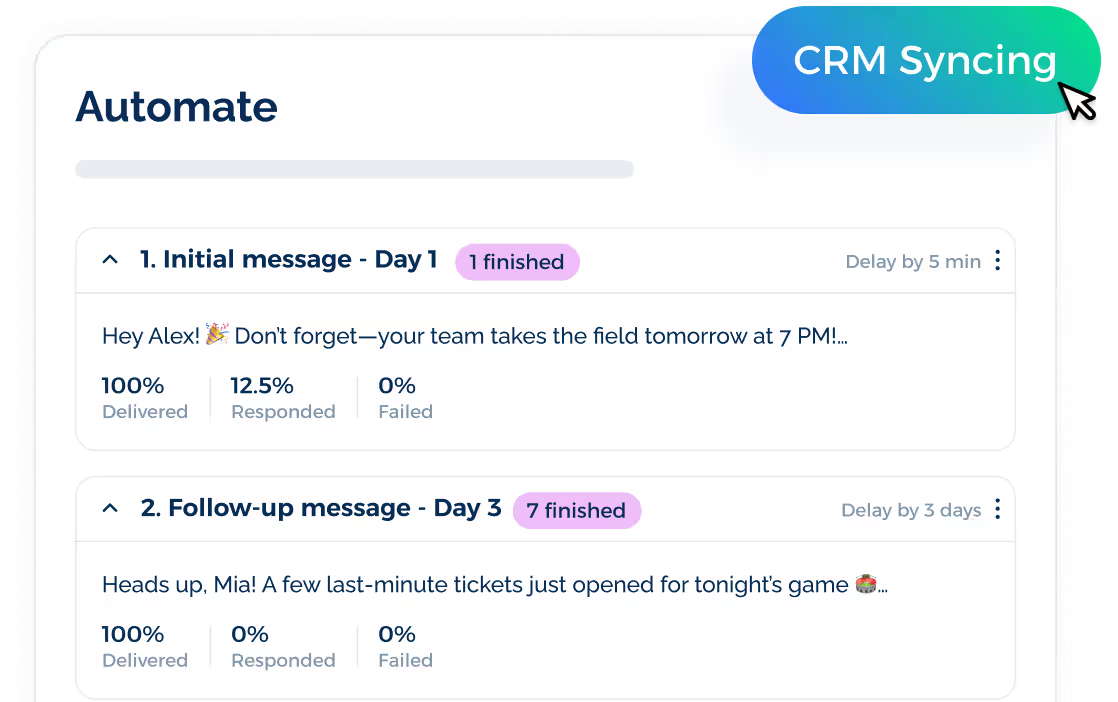
For example, when someone joins your list, an automatic text can greet them with a short offer or an introduction to your business.
When there's a missed order or abandoned cart, an automated SMS marketing campaign can remind customers to return. These simple actions increase sales and strengthen loyalty.
Automation also helps you respond to customer behavior. When a customer buys a product, you can schedule future messages that offer related items. If a user has not opened texts for a while, a reactivation message can invite them back.
You can also use automation to send messages at the best times. Data from past campaigns shows when reply rates or click links are high. Using that information, you can reach customers when they are most active.
6. Use Compelling Call-to-Actions (CTAs)
Every SMS campaign should tell your audience what to do next. A specific CTA turns a short message into a result, whether that means a sale, a reply, or a visit to your store.
Simple phrases like “Shop Now,” “Claim Your Offer,” or “Reply YES to Confirm” guide your readers instantly.

People read text messages quickly, so they need a next step they can take right away. You can also use trackable links to see which messages drive the most clicks.
You can use action-based language that matches your goal. If you want to encourage customers to schedule, your message might say, “Tap to book your free session.”
If you want to promote a sale, use urgency: “Order before 5 PM to save 20%.” Urgent yet polite CTAs increase customer engagement and create quick responses.
You can also add variety to your CTAs to keep them interesting. Rotate between discount codes, surveys, and invitations to events. You can implement SMS customer surveys to collect feedback and learn what drives responses.
Finally, make your CTA placement on its own line so it stands out inside the text message inbox. End your promotional SMS marketing messages with the action you want customers to take.
7. Track and Optimize Campaign Performance
You cannot improve your SMS marketing strategy without tracking results. Measuring performance helps you make smarter decisions for future SMS marketing campaigns.
Key metrics like delivery rate, open rate, click rate, and unsubscribe rate show how well your text messages reach people and how they react. A high open rate means your audience notices your texts, while a low click rate often points to weak marketing messages or unclear offers.
You can also monitor customer behavior through link tracking and response data. If customers click a product link but do not buy, you can send a follow-up discount or reminder. Small adjustments like these often lead to stronger customer engagement and higher returns.
You can try A/B testing as part of your process. Send two versions of a message to small groups, then measure which version performs better. One might have a different tone, timing, or promotional SMS messages. You can use the winning version for your next SMS campaign.

8. Combine SMS With Other Channels
Texts, emails, and social posts work best when they support each other instead of competing for attention.
You can start with email marketing. It helps you share longer content like newsletters or promotions, while SMS campaigns handle short, urgent messages.
For example, you can announce a new product through email, then follow up with a quick text reminder before the offer expires.
You can also integrate SMS with paid ads or social media. When someone clicks a social ad, invite them to subscribe to texts for faster updates or promotional SMS messages. This simple move expands your list and makes your mobile marketing stronger.
SMS integration across multiple platforms helps you track and understand customer behavior. You can see which ads, emails, or texts lead to the most sales. With this insight, you can send personalized messages through the right communication channels.
9. Use the Right SMS Platform
The tool you use affects how easily you can send marketing text messages, track results, and stay compliant with laws.
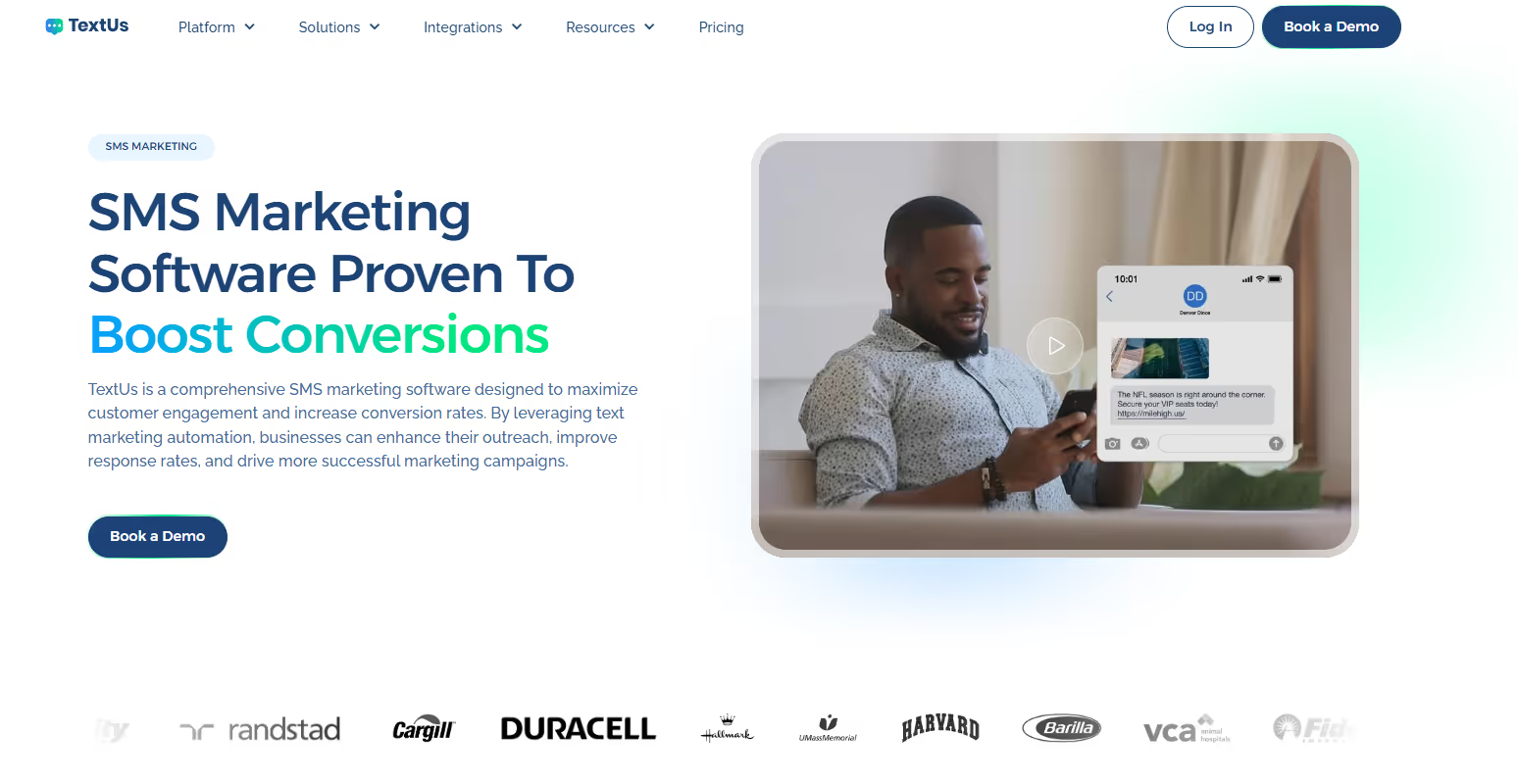
TextUs is the best SMS platform as it offers the power, flexibility, and security that you need to manage your texting at scale. Here are its key features that make it stand out:
- Unlimited campaign sizes: Send personalized bulk text messages to large lists
- Automated drip campaigns: Schedule follow-ups that nurture leads automatically
- Custom keyword triggers: Create smart workflows that react to SMS keywords
- Rich media and branded links: Send promotional SMS messages with visuals, PDFs, or branded short links
- Two-way texting: Hold real conversations with customers using shared inboxes, a mobile app, or a Chrome extension
- Built-in templates and quick replies: Save time with reusable marketing messages and quick-reply suggestions
- Advanced analytics: Get real-time dashboards that show delivery rates, engagement, and response speed
- Flexible CRM integrations: Easily integrate SMS with your CRM and other marketing channels
- Compliance and security: Automatic opt-in and opt-out handling, role-based user controls, message audit trails, and encryption
TextUs gives you the tools to reach more people and protect your brand’s reputation. You can handle SMS subscribers at any scale while maintaining personal connections through two-way communication.
Make Texting Your Competitive Advantage—Try TextUs!
Now that you’ve read about the best practices, it’s time to apply them with the right tool.
TextUs helps your business make the most of the benefits of SMS marketing by turning simple messages into real conversations. It lets you send personalized texts, manage compliance, and organize every campaign from one easy-to-use platform.
With two-way texting, automation, and built-in analytics, TextUs makes it easy to connect with customers while following every rule of good texting etiquette.
The platform is built for results. You can send large-scale SMS marketing campaigns and schedule follow-ups that drive engagement. Features like keyword triggers, branded links, and automated drip campaigns let you handle every part of your SMS marketing efforts.
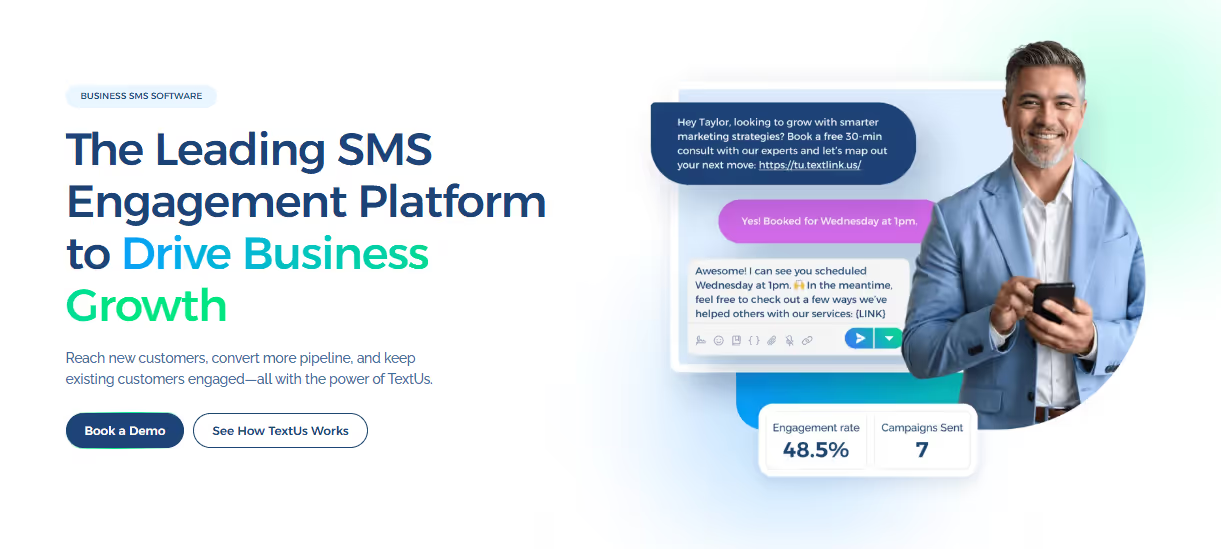
If you want to turn text message marketing into a trusted growth channel for your business, TextUs is the platform you need. Book a demo today and build stronger customer relationships!
FAQs About SMS Marketing Best Practices
What is the best practice for SMS frequency?
Most businesses see the best results with 2-4 SMS campaigns per month. That frequency keeps your audience aware of your brand without sending too many messages that feel intrusive.
You need to focus on relevant messages that provide real value instead of random updates. If engagement drops, reduce frequency and test new timing until you find what your audience prefers.
These adjustments are among a few tips that can keep your overall marketing strategy consistent and effective.
Is SMS marketing's open rate 98%?
Yes. Studies across the mobile marketing industry confirm that text messages have an open rate of about 98%. People keep their mobile devices nearby, so they read texts almost instantly.
This high open rate proves that SMS marketing works for quick communication, promotions, and updates. It also shows why more businesses now use texting to alert customers and strengthen connections faster than email or ads.
What type of messages are most effective in SMS marketing?
The most successful messages are short and action-driven. Promotional SMS messages such as discounts, limited-time offers, and product launches perform well.
Transactional messages like order updates or appointment reminders also build trust. You can include links, codes, or SMS surveys to invite responses and gather customer feedback.
The key is to send marketing messages that fit the customer’s stage in the customer journey and add value.
Is SMS marketing effective for small businesses?
Absolutely. SMS gives small businesses a low-cost way to engage customers, boost visibility, and build loyalty. You do not need a massive team or expensive systems to start.
With the right SMS marketing tool, you can create targeted messages, send personalized updates, and track performance easily. A platform like TextUs helps you automate campaigns, manage customer behavior data, and stay compliant while growing your list of SMS subscribers.
Continue Reading
Frequently Asked Questions
Business Texting
Built for Results
Create and convert pipeline at scale through industry leading SMS software




